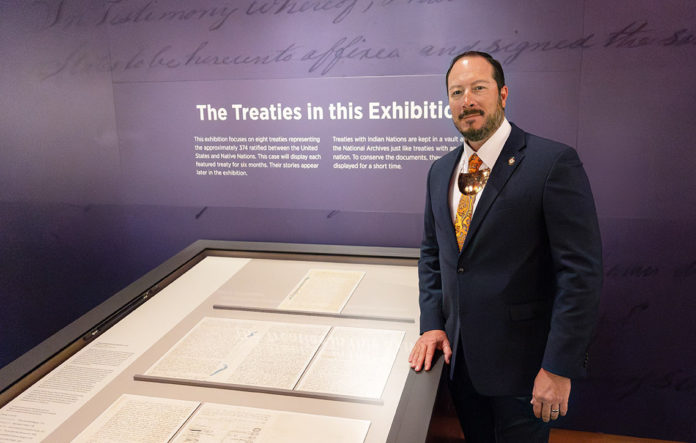WASHINGTON, D.C. – Cherokee Nation Deputy Principal Chief Bryan Warner visited the National Museum of the American Indian (NMAI) this week for the unveiling of Cherokee Nation’s historic Treaty of 1828. This important treaty with the federal government marked a defining moment in Cherokee history, as it established the initial boundaries of the modern-day Cherokee Nation reservation and affirmed the unity of the Cherokee people as one Nation.
In his public remarks with the NMAI staff, Deputy Chief Warner reflected on the significance of the treaty and its lasting impact on the Cherokee Nation.
“This treaty, forged in a time of hardship and displacement, speaks to the resilience and unity of the Cherokee people,” said Warner. “Even when our ancestors were forced from our homelands in the Southeast and confronted by new challenges west of the Mississippi, we remained one people and one Nation. The Treaty of 1828 made no distinction between the Western Cherokees and those who remained in the East. It recognized the Cherokee Nation as a whole, and today, as we unveil this document, we honor that legacy of unity and strength.”
The Treaty of 1828 was signed as part of a series of agreements that relocated the Cherokee people to lands in Indian Territory, modern-day Oklahoma. Federal officials hoped that all Cherokees would reunite in the West as one nation. Today, the United States recognizes three Cherokee tribes: the Cherokee Nation in Oklahoma, the Eastern Band of Cherokee Indians in North Carolina, and the United Keetoowah Band of Cherokee Indians in Oklahoma.
Subsequent to the treaty, Cherokee Nation endured removal, divisions and ultimately reunification in the decade following removal. Cherokee Nation is the only Cherokee tribe to have ever signed a treaty with the United States. The display of the treaty at NMAI serves as a powerful reminder of the Cherokee Nation’s perseverance through centuries of struggle. The museum, in partnership with the Cherokee Nation, is committed to preserving and showcasing significant artifacts like the Treaty of 1828 to educate and inspire future generations.
“This document is not just a part of our history, but a testament to our endurance,” said Warner. “We are proud to stand here today and reaffirm our continuous government-to-government relationship with the United States.”
Although the treaty itself was born out of conflict and displacement, it recognized the Cherokee people as a single, unified government body. That nation-to-nation acknowledgment remains foundational and intact today.















































